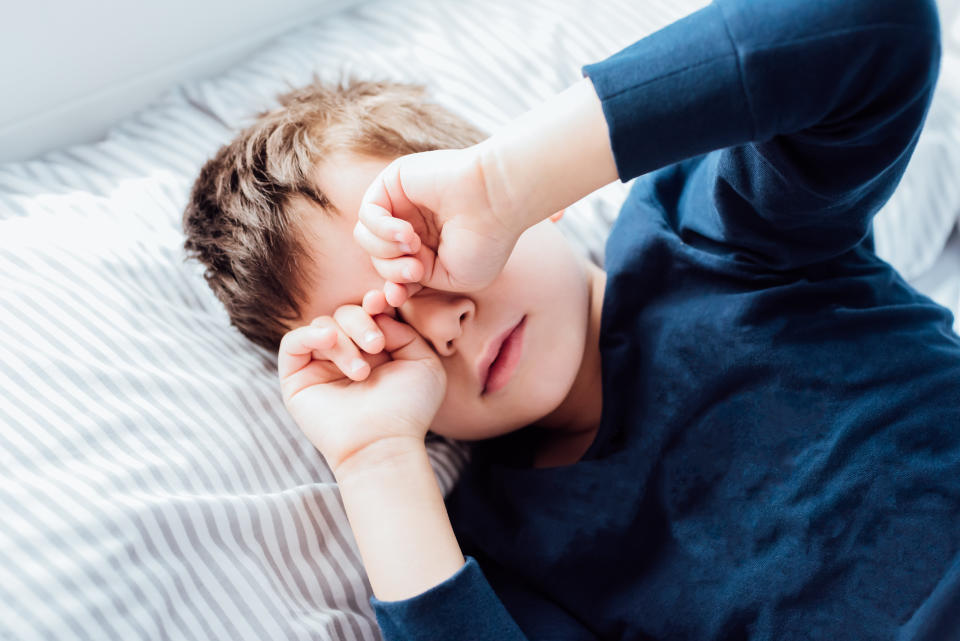Doctors Have ID'd A New Sleep Disorder In Kids. Here's What Parents Should Know.

Parents know they are not going to get much sleep when they have a new (or, yes, even new-ish) baby at home. In fact, research suggests parents don’t sleep all that well for the first six years of their children’s lives.
But eventually, the majority of children and families settle into a routine, and the nights become more restful. So when kids are still struggling, doctors start to consider more serious underlying sleep disturbances, which affect up to 30% of babies and children.
Researchers have just defined a new one: restless sleep disorder, or RSD. The condition affects children between the ages of 6 and 18 who toss and turn far more than is typical. They often have a difficult time focusing and face emotional and behavioral challenges as a result.
The researchers who defined the new disorder last month say it represents an exciting step forward in the world of pediatric sleep science, providing a “why” for many families who have failed to help their children get enough high-quality sleep and opening up an option for treatment.
“Before this, we didn’t have the tools — a standard of diagnosis — to say, ‘Oh yes, your child has restless sleep disorder,’” Dr. Lourdes DelRosso, a sleep physician at the University of Washington School of Medicine and Seattle Children’s Hospital, told HuffPost. DelRosso was the first to study RSD and led a 10-person international task force that, over 18 months, set forth diagnostic criteria for the newly defined disorder.
There wasn’t really anything doctors could do for those children previously, DelRosso said, and “that’s what makes this very important,” she argued.
It is too soon to say how common RSD may be, although DelRosso estimates that about 7% of the children she sees in her sleep lab may have the disorder.
For Melissa Caveness, a Washington-based mom of three, the new diagnosis has been game-changing. Her youngest daughter, Emily, was diagnosed with RSD after thrashing in bed at night basically since infancy. She kicked her blankets off and frequently fell out of bed. And if Emily slept with her parents, one of them would inevitably end up with a fat lip or black eye, Melissa recalled to HuffPost.
Eventually, Emily’s inability to get a truly restful night’s sleep began undermining her behavior. “It was hard for her to focus. She was constantly moving. She was cranky,” Melissa told HuffPost. She and her husband felt fairly certain it had something to do with her sleep, and they tried everything: strict sleep routines, melatonin, calming music, meditation.
At age 7, Emily’s pediatrician referred her to Seattle Children’s Sleep Medicine Clinic for a sleep study (an overnight stay in a lab). Emily and her family connected with DelRosso, who told them about her work on RSD.
And that is when things began to turn around for Emily and her family — because the treatment for RSD is generally pretty simple: iron supplementation. Although work into the mechanisms underlying RSD is ongoing, DelRosso and her colleagues have found a strong tie between nighttime restlessness and low levels of ferritin, a blood protein that stores iron.
It is too soon to say exactly how many children who have RSD have iron deficiencies, and whether that is the specific cause of the disorder. DelRosso is also studying the possible role the sympathetic nervous system (basically, the system that controls the fight-or-flight response) plays in RSD, as well as a link between sleep instability (choppy, non-consolidated sleep) and these kinds of large, constant movements.
Emily, who is now 9, was given an intravenous iron infusion followed by ongoing supplementation, and Melissa said the change in her daughter was profound and almost immediate.
“We can snuggle and sleep with her and she doesn’t hurt us,” she said. “She doesn’t fall out of bed. She’s not a tornado anymore. She wakes up on her pillow, happy instead of angry with bags under her eyes.”
But even though that research is still evolving, DelRosso said she hopes the formal definition of this new disorder will spread to pediatricians and other clinicians who can at least let struggling families know it’s a possibility. A diagnosis requires meeting eight criteria, including a sleep study confirming children are having five or more large body movements per hour and the continuation of disrupted nights at least three nights a week, for more than three months.
Because parents can play such a key role in helping kids get diagnosed, DelRosso urged all caregivers to take sleep seriously and to seek an outside opinion if their kids aren’t getting the rest their growing brains and bodies need.
“Keep an eye on it over time,” she said. “Disorders like restless sleep disorder can be chronic. They won’t just go away.”
Also on HuffPost
Love HuffPost? Become a founding member of HuffPost Plus today.
This article originally appeared on HuffPost and has been updated.


